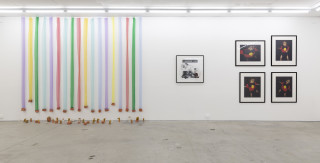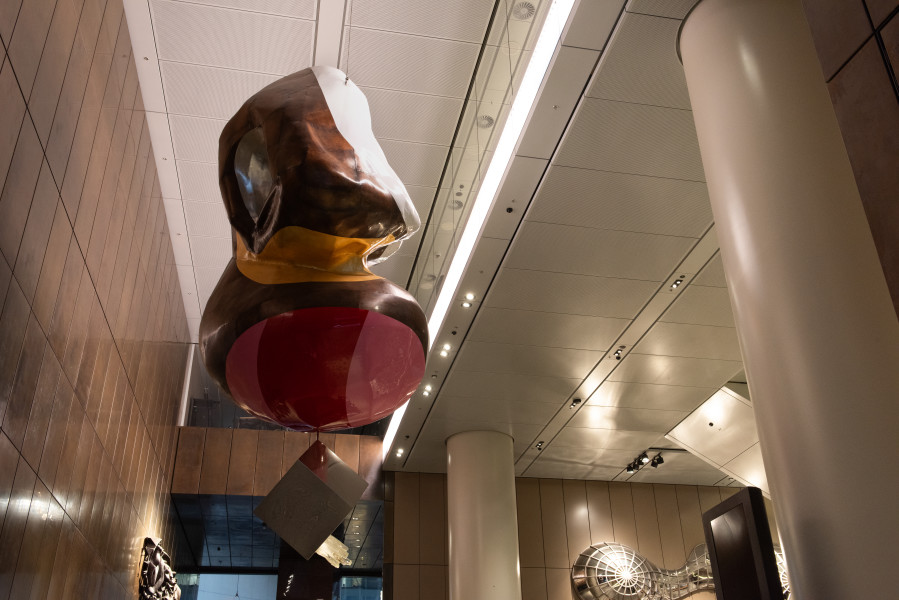The cave-like forms of Shelter of Hollows reference the cavernous tunnel infrastructure of underground train travel. Organic, bejeweled and mysterious, the sculpture—commissioned specially for 1 Elizabeth—refers both to shapes found in the natural world and the resources extracted from the ground that we rely upon to build and activate cities.
The cave-like forms of Shelter of Hollows reference the cavernous tunnel infrastructure of underground train travel. Organic, bejeweled and mysterious, the sculpture - commissioned specially for 1 Elizabeth - refers both to shapes found in the natural world and the resources extracted from the ground that we rely upon to build and activate cities.
According to the artist, “Its earthen materials — ceramics, metal and glass — are the stuff of trains and stations, the substance of wheels, machines, windows and long tiled walls. In Shelter of Hollows, they form an object suspended literally across time passing, one that silently occupies the space above the comings and goings”.
The work relates visually and conceptually to other sculptural installations in 1 Elizabeth Street and the immediate vicinity. Dwyer’s other work here, a highly reflective Mobius strip, is suspended at the northern entrance. One of the inspirations for Dwyer’s two works were the organic forms of Margel Hinder’s Abstract Sculpture (1961), located in the forecourt of the nearby Reserve Bank of Australia.
Other important points of reference for Dwyer were the 1960s sculptural installations by Tom Bass and Douglas Annand, which have also been incorporated into 1 Elizabeth. In addition to sharing an interest in the intersection between natural and built forms, Dwyer has incorporated materials used by Bass and Annand – specifically metals and clay. In its relationship with these earlier artworks in the area, Shelter of Hollows opens a cross-generational dialogue around sculptural form, organic abstraction, symbolism and materiality.
––
Text courtesy 1 Elizabeth
 Group Show, A Fictional Retrospective: Gertrude’s First Decade 1985–1995
Group Show, A Fictional Retrospective: Gertrude’s First Decade 1985–1995
Gertrude Contemporary, 2025
 Mikala Dwyer Skyring
Mikala Dwyer Skyring
Roslyn Oxley9 Gallery, 2024
 Mikala Dwyer Shelter of Hollows
Mikala Dwyer Shelter of Hollows
1 Elizabeth, Martin Place Station Sydney Metro, Sydney, 2024
 Mikala Dwyer Continuum
Mikala Dwyer Continuum
Martin Place Station Sydney Metro, Sydney, 2024
 Group Show, The First 40 Years
Group Show, The First 40 Years
Roslyn Oxley9 Gallery, 2024
 Group Show, nightshifts
Group Show, nightshifts
Buxton Contemporary, 2023
 Mikala Dwyer Penelope and the Seahorse
Mikala Dwyer Penelope and the Seahorse
Chau Chak Wing Museum, 2023
 Mikala Dwyer Chromakinda
Mikala Dwyer Chromakinda
Kids Gallery, MAMA, 2022-23
 Mikala Dwyer Mikala Dwyer: The silverings
Mikala Dwyer Mikala Dwyer: The silverings
Museum of New Zealand Te Papa Tongarewa, 2022
 Group Show, Still Life
Group Show, Still Life
Buxton Contemporary, 2022
 Group Show, Pliable Planes: Expanded Textiles & Fibre Practices
Group Show, Pliable Planes: Expanded Textiles & Fibre Practices
UNSW Galleries, 2022
 Group Show, The Great Invocation
Group Show, The Great Invocation
Garage Rotterdam, Netherlands, 2021
 Mikala Dwyer Bird
Mikala Dwyer Bird
Roslyn Oxley9 Gallery, 2021
 Mikala Dwyer Wishing Wells
Mikala Dwyer Wishing Wells
Ichiahara Art+Mix Triennale, Japan, 2021
 Mikala Dwyer Phantom
Mikala Dwyer Phantom
animation on Hologauze, MUMA, Monash University, 2021
 Mikala Dwyer Bay of Sick
Mikala Dwyer Bay of Sick
Adelaide Biennial of Australian Art, 2020
 Group Show, Idol Worship
Group Show, Idol Worship
Lismore Regional Gallery, NSW, 2019
 Group Show, Mondspiel
Group Show, Mondspiel
Buxton Contemporary, Melbourne, 2019
 Group Show, Workshop
Group Show, Workshop
University of Queensland Art Museum, Brisbane, 2019
 Mikala Dwyer Earthcraft
Mikala Dwyer Earthcraft
Govett-Brewster Art Gallery | Len Lye Centre, New Zealand, 2019
 Mikala Dwyer Soft Relics
Mikala Dwyer Soft Relics
Roslyn Oxley9 Gallery, 2018
 Group Show, The shape of things to come
Group Show, The shape of things to come
Buxton Contemporary, 2018
 Group Show, State of Play
Group Show, State of Play
Roslyn Oxley9 Gallery, 2017
 Mikala Dwyer A shape of thought
Mikala Dwyer A shape of thought
Art Gallery of New South Wales, Sydney, 2017-18
 Group Show, Soft Core
Group Show, Soft Core
Casula Powerhouse Arts Centre, 2016
 Group Show, Wonder: Contemporary Art for Children
Group Show, Wonder: Contemporary Art for Children
Hazelhurst Arts Centre, 2016
 Group Show, Dämmerschlaf
Group Show, Dämmerschlaf
Artspace, Sydney, 2016
 Mikala Dwyer Square Cloud Compound
Mikala Dwyer Square Cloud Compound
Museum of Contemporary Art Australia, Sydney, 2015-16
 Mikala Dwyer The Letterbox Marys
Mikala Dwyer The Letterbox Marys
Roslyn Oxley9 Gallery, 2015
 Group Show, Dead Ringer
Group Show, Dead Ringer
Perth Institute of Contemporary Arts, Perth, 2015
 Mikala Dwyer Hall of Half-Life
Mikala Dwyer Hall of Half-Life
GrazMuseum, Austria, 2015-16
 Mikala Dwyer Magnetism
Mikala Dwyer Magnetism
Hazelwood, Sligo, Ireland, 2015
 Mikala Dwyer Redlands Konica Minolta Art Prize
Mikala Dwyer Redlands Konica Minolta Art Prize
National Art School Gallery, Sydney, 2015
 Mikala Dwyer The Garden of Half-life
Mikala Dwyer The Garden of Half-life
University of Sydney Art Gallery, Sydney, 2014-15
 Mikala Dwyer The Hollows
Mikala Dwyer The Hollows
19th Biennale of Sydney, 2014
 Mikala Dwyer Goldene Bend'er
Mikala Dwyer Goldene Bend'er
Australian Centre of Contemporary Art, Melbourne, 2013
 Group Show, Future Primitive
Group Show, Future Primitive
Heide Museum of Modern Art, Melbourne, 2013-14
 Group Show, Ten Years of Things
Group Show, Ten Years of Things
UQ Art Museum, 2012-13
 Mikala Dwyer Eggswing
Mikala Dwyer Eggswing
Royal Hospital for Women Park, Sydney, 2012-13
 Mikala Dwyer Divinations for the real things
Mikala Dwyer Divinations for the real things
Roslyn Oxley9 Gallery, 2012
 Mikala Dwyer Drawing Down the Moon
Mikala Dwyer Drawing Down the Moon
Institute of Modern Art, Brisbane, 2012
 Group Show, Panto Collapsar
Group Show, Panto Collapsar
Project Arts Centre, Dublin, 2012
Mikala Dwyer Windwatcher
Central Park, Sydney, 2011
 Mikala Dwyer An Apparition of a Subtraction
Mikala Dwyer An Apparition of a Subtraction
17th Biennale of Sydney, 2010
Mikala Dwyer Mary's Place Lamp
Surry Hills, Sydney, 2010-13
 Callum Morton Before and After Science
Callum Morton Before and After Science
Adelaide Biennial of Australian Art, 2010
 Group Show
Group Show
Roslyn Oxley9 Gallery, 2009-10
 Mikala Dwyer Outfield
Mikala Dwyer Outfield
Roslyn Oxley9 Gallery, 2009
Mikala Dwyer Moongarden, Aratoi
Wairarapa Museum of Art and History, New Zealand, 2008-09
 Group Show, Lucky Town
Group Show, Lucky Town
Roslyn Oxley9 Gallery, 2008-09
 Mikala Dwyer Black Sun Blue Moon
Mikala Dwyer Black Sun Blue Moon
Spielhaus Morrison Galerie, Berlin, 2007
Mikala Dwyer Swamp Sculpture
Omi Sculpture Park, New York, 2006
Group Show, IOU
Helen Lempriere National Sculpture Award, Melbourne, 2002
Mikala Dwyer
Museum of Contemporary Art Australia, Sydney, 2000
Mikala Dwyer Primavera
Museum of Contemporary Art Australia, Sydney, 1992




